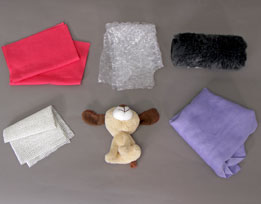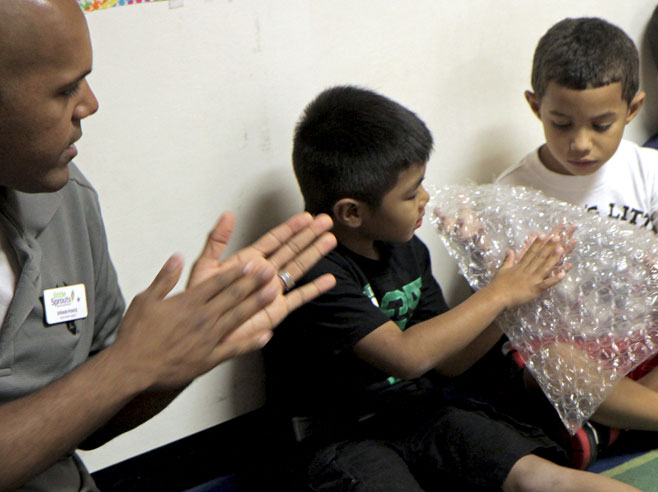Children pass around items with different textures and describe how they feel. Then they compare how it feels to skate in sock feet on a smooth floor versus a fuzzy carpet.
Materials

- 5–8 objects or materials with different textures (such as a washcloth, plush toy animals, a piece of corduroy, sandpaper, felt, crumpled aluminum foil, bubble wrap)
- 2 floor surfaces for children to skate on: one smooth and one carpeted (see Preparation section)
Preparation
- Locate or create in your classroom an area with a smooth bare floor next to a carpeted surface. If needed, use a large piece of foam core or cardboard to serve as a smooth floor surface, or an area rug to serve as the carpeted surface.
Directions: Lesson 8
Circle Time: Introduction
- Pass around different-textured objects or materials for children to touch and describe. Introduce the word texture. Possible discussion ideas:
- What texture is the (blanket)?
- Does it feel smooth or rough? Is it fuzzy? Soft? Scratchy? Bumpy?
- Does it feel like something you have felt before? Encourage children to use lots of different descriptive words and phrases.
- Have children rub two fuzzy, rough, or bumpy objects or materials together. Explain that when two objects rub together, they cause friction. Have children listen to the sound made when they rub the rough objects together.
- Point out that there is quite a bit of friction when you rub rough-textured objects together.
- Explain that friction will slow down objects that are moving.
- Have children compare rubbing their hand against a rough or bumpy surface, such as a piece of sandpaper, and rubbing their hand against a smooth surface, such as a tabletop. They will feel more friction when they rub the rough surface than when they rub the smooth surface.
- Tell children that they are going to try skating in their socks on two surfaces: the bare floor and carpet. Possible discussion ideas:
- Which is smoother: the bare floor or the carpet?
- Which is rougher or bumpier: the bare floor or the carpet?
- Where do you predict you will feel more friction (rub your hands together with some resistance to mime the word): when you are skating on the bare floor with socks on, or when you’re skating on the carpet?
- On which surface do you predict you will slide farther? Why? Let’s try it!
- Divide children into groups and have one group at a time try skating on the bare floor and on the carpet. When everyone has had a turn, encourage them to use words and actions to describe the friction they felt when skating on each surface.
- Why did you not slide as far on the carpet as you did on the bare floor?


